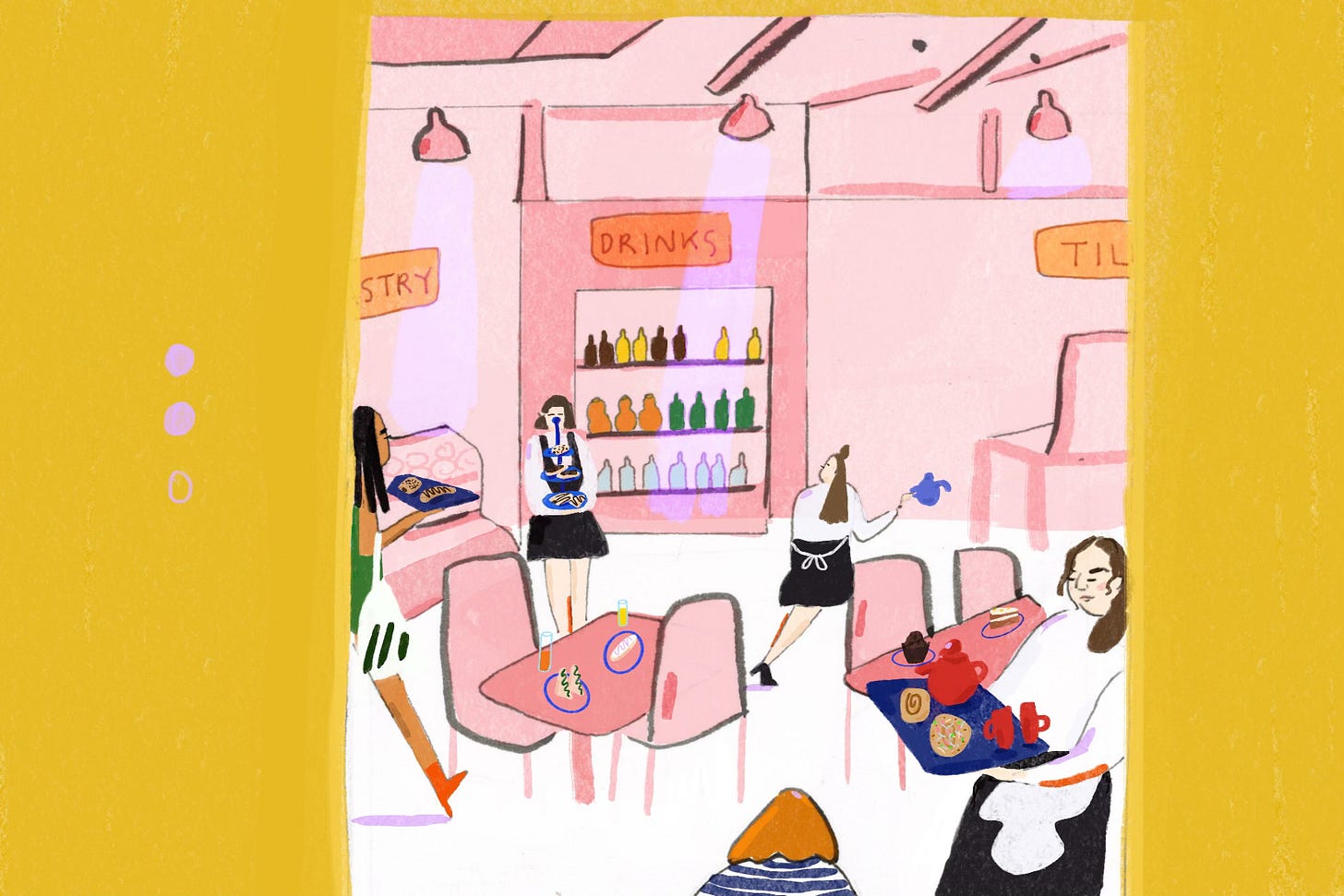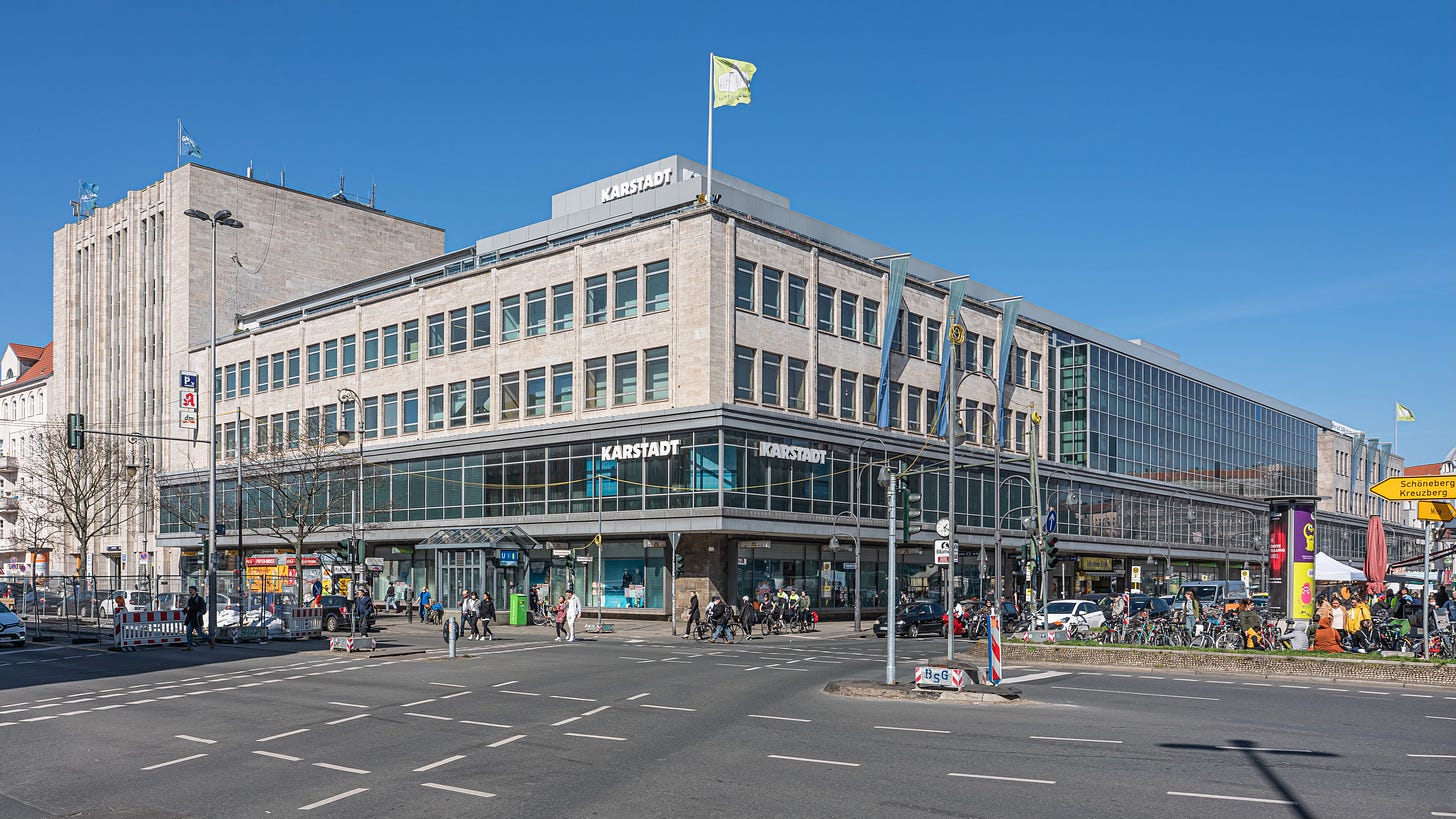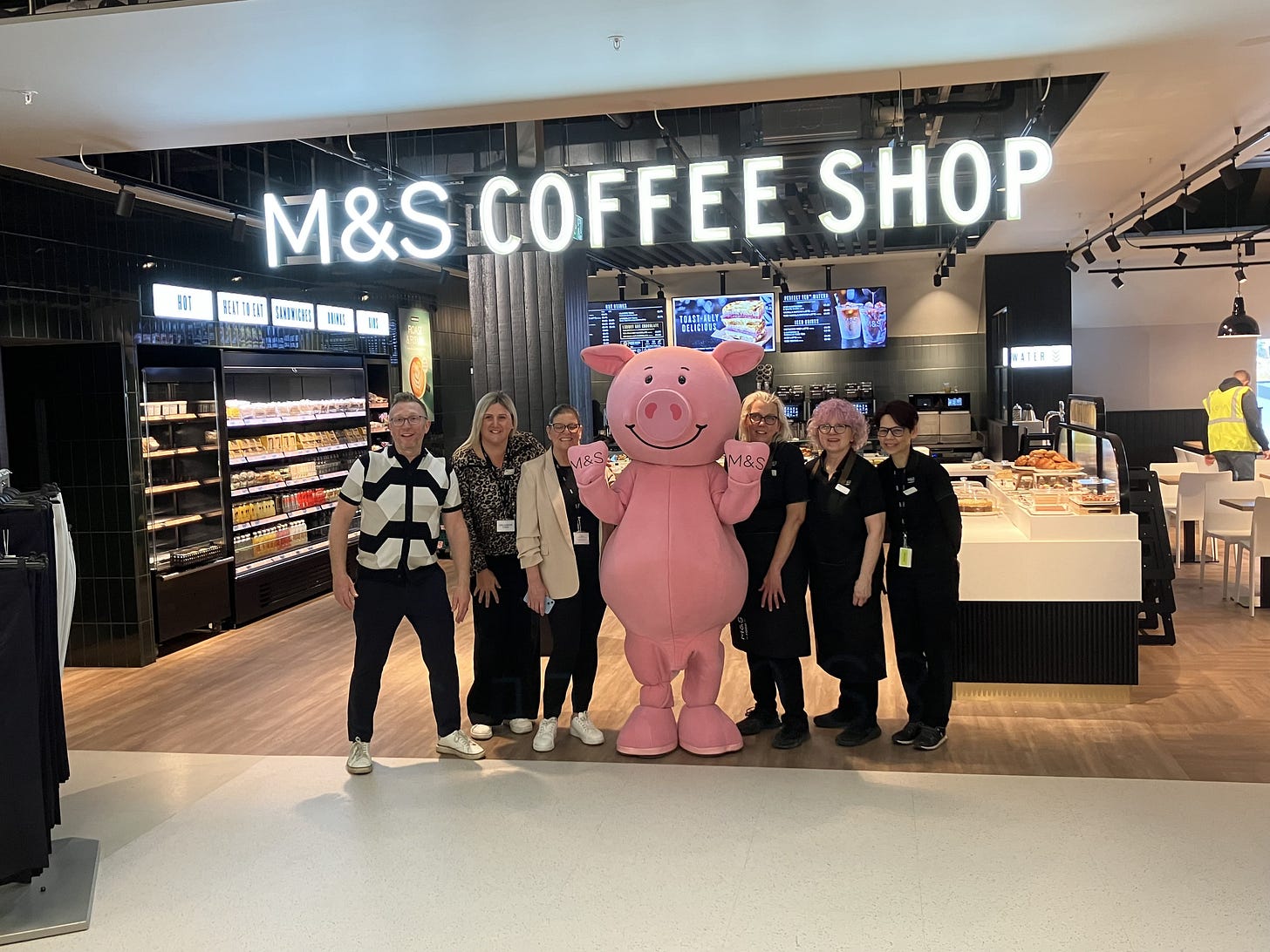Slinging the Dainties
Lauren J Joseph on the peculiar charms of department store cafes. Illustration by Jess Nash.
Good morning, and welcome to Vittles! In today’s essay, Lauren J Joseph reflects on the odd allure of department store cafes, and the role they have played in her life.
When the elevator doors closed, I was still inside. I was only four, but I remember thinking, Well, I’ll probably never see my mother again. She had stepped out a few seconds earlier, pushing my little sister in her buggy, but I had been dawdling as usual. The lift went down to the basement then zipped back up, emptying and filling again with shoppers all far too distracted to notice me. At some point I considered getting out, but the building seemed so cavernous I thought I’d be lost for good if I did. So I stayed put, waiting on a miracle.
The lift was deep inside Liverpool’s illustrious George Henry Lee’s, a department store in grand Edwardian style – all marble pillars, dark wood and Grecian key-motif ironwork, with a staircase that would’ve made Joan Crawford proud. Officially it was a branch of John Lewis, though no one in the city was having it. Each time the big brass elevator doors opened, the tableau changed: a huddle of housewives buying balls of wool; teen girls spritzing bottles of Obsession by Calvin Klein; a few al’ fellas handling golf clubs; the grace and drama of the gift-wrap counter. I saw it all before my mother found me again.
The scene that thrilled me more than any other, though, was the brief glimpse of unutterable glamour that I snatched on the third floor: the in-store cafe, where matrons in court shoes and pinnies served tea and buns to lucky little boys and girls who, under the watchful glare of their parents and on pain of death, sat nicely and politely while fashion models swished by, showing off the frocks from downstairs. The only evidence I have that I was not staring out on 1967 is the distinct memory of all those feathered mullets and the chorus of ‘I Should Be So Lucky’ playing over the speakers. I could’ve only been looking at the cafe for thirty seconds, but the pure cinematic elegance of that scene remains with me. A life-long fixation was born.
In every city I visit, I make a beeline for department stores – not just to shoplift lip gloss, but to take a perch in the canteens and scope out the town. Department stores offer a cross-section of society second to none; you’ll always find bored, rich shoppers alongside nanas on a big day out, new parents nursing and tourists alike. In Mexico City I hiked to the top floor of El Palacio de Hierro for a bistec ranchero; while visiting Tokyo I muddled my way through the Ginza Mitsukoshi for saba shioyaki. Both were delightful, but they couldn’t hold a candle to the Kaffee und Kuchen at Karstadt on Berlin’s Hermannplatz. I remember watching a gaggle of some fifteen old ladies there – they were sitting and singing pop songs from the fifties, to the absolute fascination of the Canadians on the next table who were cramming for a German language exam. There was something so bizarrely moving about the scene: the cafe was functioning for them, and I felt as though I were seeing a whole new side of a city I already knew well. I wrote large chunks of my new novel in the Karstadt cafe because it was the only place in the city with reliable air conditioning, and every second coffee was half price. That’s one of the many magical things about department store cafes: the ways in which customers use the space are almost endless. They are study hubs, pit stops, hot spots for reunions.
Although the UK’s first department store opened in the eighteenth century, it wasn’t until Selfridges arrived on the scene in 1909 that the country got its first in-store cafe, the Palm Court. Harry Gordon Selfridge (who, incidentally, also once owned George Henry Lee’s) brought this side hustle with him from his previous post at Marshall Field’s in Chicago. Almost immediately, the Palm Court became the spot for Edwardian baddies to chill, prompting other stores to quickly follow suit with restaurants of their own. Harrods opened one in 1911, as did Whitleys, while Fortnum’s didn’t start slinging the dainties in store until 1926.
Being able to stuff yourself with gingerbread between stuffing yourself into girdles remade the shopping experience. Department stores, and the cafes within, were some of the first public spaces in which women could socialise safely and without risking their reputation. Suffragettes met in the tea rooms, while less wealthy women were offered employment on the sales floor. Apparently there was even an all-girl gun club on the roof of Selfridges.
I’ve had some fascinating experiences of my own in department store cafes over the years. In Berlin, I knew a musician who had toured the world with Blondie, Bowie and Moby. When she moved to die Hauptstadt I persuaded her that the best place to throw herself a party would be Le Buffet at Karstadt. She took my suggestion and, honestly, the sight of some thirty rock’n’rollers necking mini bottles of Sekt, flanked on all sides by elderly Germans with their plates of Hering und Kartoffelsalat, was a thing of rare beauty. Of course, the scenes don’t have to be quite so raucous to be memorable. Once I saw Alan Hollinghurst fiddling with a gluten-free lemon drizzle bar in The Place to Eat at John Lewis, and that was a thrill in itself.
As a category, department store cafe is pretty expansive, encompassing both the most basic and the utterly extravagant. They run the gamut from the humble Cafe Zest at Frasers to the infamous Three Darlings pop-up at Harrods (home of the £52 hot dog, co-designed by David Gandy). What unites them all, however, is their functional elegance and peculiar liminality. The real joy of these places is how well they continue to function as third spaces – especially those at the more, shall we say, workaday end of the market. They are often more affordable – and stay open later – than other cafes. Dear old M&S offers coffees from £2, and some of their cafes stay open until 9pm, which is practically like living in Spain. They tend to be quieter than pubs and more low-key than restaurants, and as a result they bring together a real mixed salad of people: parent-and-baby groups sipping alongside university students cramming for hours on end, frazzled tourists, well-heeled shoppers weighed down with bags, and people paying for their soup with coins collected in a paper cup.
Whether intentionally or not, department store cafes are spaces of ambivalence and ambiguity that refuse any one fixed understanding. At this point I’ve probably spent years of my life in them: I’ve broken up with boyfriends, had business meetings, filed my taxes and argued politics in them. They’re so meaningful because their meaning is so malleable, defined by the user as few experiences really are in our world of phoney ‘Have it your way’ marketing spin. There’s something almost anarchic about department store cafes, if only because they are paid so little attention. To some people they still represent an elegance last seen in the ITV adaptation of Brideshead Revisited; to others, they’re merely a basic necessity like a public loo, a place to sit and cry when you have overnight guests due in an hour but can’t remember if your sofa bed is a small double or a queen. Department store cafes are polyvalent enough to support almost any reading – a treat, a chore, a respite, a glimpse of a more egalitarian society.
Unless I’m travelling abroad, I usually don’t order food, just coffee or sparkling water. I like to sit myself within earshot of the action but not at the centre of it – usually on the perimeter of the room, at a table with good sight lines. It’s important that I can see the comings and goings, what’s in flux and what remains the same. In these cafes, an inescapably outmoded sense of sophistication competes constantly with foodie fads; they face the challenge of being both unchanging and bang on-trend. Hence we have a collagen latte on the menu of Dolly’s at Selfridges, and M&S Café offering sunshine bowls and smashed avo next to toasted teacakes. Marksies seem particularly determined to go viral with their hacked coffees (ie lattes with a shot of syrup), which don’t officially appear on the menu and are therefore only available for iykyk girlies. Yet in-store dining remains pleasingly antiquated: after all, no amount of Jamie Oliver-washing is going to overwrite the essential experience of queuing behind a gaggle of bemused yanks trying to figure out what the hell a crusty roll might be, all while trying to balance a sandwich and a slightly chipped tea pot on an needlessly large melamine tray, is it?
Department stores have been steadily vanishing from the high street since the 1970s, with the rate of decline noticeably increasing in the last twenty years or so. BHS, Littlewoods, Debenhams and many other independents have disappeared under the combined weight of e-commerce, Covid-19, shopping malls and out-of-town retail parks. Big supermarkets now often have their own in-store restaurants: many a Sainsbury’s has a Starbucks franchise tacked on, while larger branches of Morrisons and Booths offer people a place to eat after the big shop. Although reminiscent of department store cafes, these spaces come with a different cultural weighting. They don’t have any of the inherited glamour and, while they’re often serviceable, they aren’t destinations in their own right. Concurrently, in a bid to balance the books, the surviving department stores have allowed corporate coffee chains to creep into their hallowed halls. Frasers now have Caffè Neros in store, while John Lewis is suffering from a particularly bad case of Benugo.
This seems like a misstep to me. It’s a flattening we see across culture: the race to the middle, where we find inoffensive mediocrity. Inevitably, this profit-maximising standardisation process whitewashes any sense of place. It’s not those gorgey Gatwick Airport vibes – the purgatorial feeling of being outside of life – which brings in-store scoffers back again and again. No – rather, it’s memories of Santa’s grotto, getting stuck in the lift, picking out bedding for your first flat and having lunch with your gran. It’s the feeling that you’re buttering scones someplace with meaning, however mutable that meaning may be. Brand strategists might struggle to grasp who these spaces are for, and investors may be stumped as to what their worth is. But as for me, the couple sitting opposite with their grandson and the foreign exchange student who’s been FaceTiming her boyfriend for the past two hours? We’re all perfectly content in our bewilderment, thank you very much.
Credits
Lauren J Joseph is a writer and occasional movie star. She is the author of the novel At Certain Points We Touch (Bloomsbury), the experimental prose volume Everything Must Go (ITNA) and the plays Boy in a Dress and A Generous Lover (Oberon). She regularly reviews for the Guardian and the Observer, and her non-fiction has recently appeared in Granta, Refinery, The Erotic Review, and Tate Etc. Lauren’s second novel, Lean Cat, Savage Cat, is due in February 2026. Lauren has presented performance work worldwide. As an actor she has worked with artists including Shu-Lea Cheang, Alexis Langlois, and Vika Kirchenbauer, and in 2023 she played Pope Joan in the 40th-anniversary production of Caryl Churchill’s seminal play Top Girls. You can find Lauren on Instagram @lauren_j_joseph.
Jess Nash is an illustrator based in the South East; her main goal is to create moments of relatability, narrative, connection and joy. You can find more of her work at www.jessnash.co.uk.
The full Vittles masthead can be found here.






Oh my god I cannot tell you how much I love the cafe in Bradbeers, New Milton. That a small, down at heel, market town manages to sustain the oldest of old-school, Are You Being Served, type department store complete with huge haberdashery and "curtain estimator" (a phrase that sticks in my head like an earworm) is a wonderful thing, and the sense of melancholic peace that settles on me as I sit down among the purple rinses to enjoy a sausage sandwich and steel pot of tea is immense.
I have hazy memories of a Japanese restaurant in The Daks men's shop on Piccadilly (now Waterstone's): I recall it was at the intersection of kitch and exotic.
PS I was once forgotten" by my mother in the hosiery department of Bloomingdales in NYC. The saleslady (sic) marched me over to a security guard, who took me to an office and made a lost child announcement. After some time ( during which I made paper dolls from a fashion catalogue), the guard suggested I call Home. Following a discussion with my mother, he took me downstairs, hailed a taxi and sent me on my way. Those were the days.